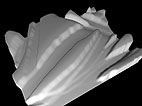| Description of the installation | ||||||||||||
| A
camera attached to the ceiling captures the activities in „Lichthof
3“. Persons in this observed area experience a direct acoustic feedback of their movements from the 4-channel speaker system hanging from crossbeams. Every moving object in the range of the camera creates a spatial sound structure, which is altered depending on size, speed and distance of the objects from one another. The sound ceases as soon as no motion is registered in „Lichthof 3“. |
 |
 |
||||||||||
|
camera signal
|
attached speaker | |||||||||||
|
|
||||||||||||
 |
 |
In the „Medientheater“
(Lichthof 5) a continuing and more complex interpretation of the captured
movements is performed, in respect of its sound as well as in respect
of a visual transformation.
|
||||||||||
 |
 |
|||||||||||
| the virtual substance | ||||||||||||
| Complementary
Documentation Before and during the exhibit of the installation, motion data gathered from the observed area is stored in regular intervals. Each day a picture is calculated showing the average movement in space over this period of time. On five weekdays each, before and during the presentation, ten motion maps are generated from which "walked-on" and "untouched" areas can be distinguished. The maps are presented in „Lichthof 3“ in form of posters. This quick-motion cartography is a supplement added to the ever-changing installation and at the same time serves as a possibility to analyze the effects of the spatial and audible feedback on human movements in the „Lichthof“. the 10 motion maps |
 |
|||||||||||
|
Motion maps in Lichthof 3
|
||||||||||||
 |
||||||||||||
